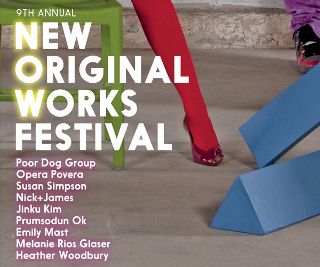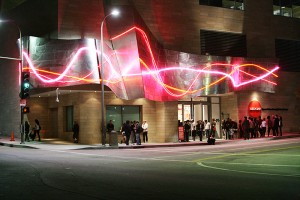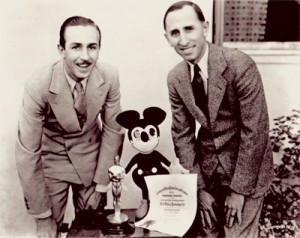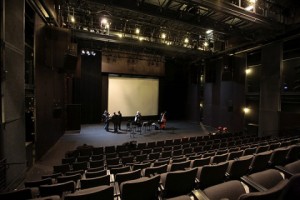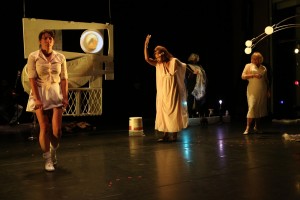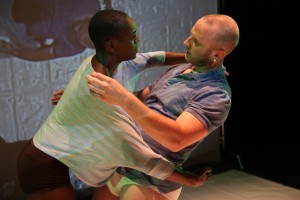BEST BE ON YOUR AVANT-GARDE
Understanding the origins of REDCAT, the downtown center for innovative visual, performing, and media arts, will assist the uninitiated in preparation for the avant-garde 9th Annual New Original Works Festival, now playing through August 11, 2012. And if you don’t like some of what you see at the festival, knowing more about REDCAT should encourage you to return time and again.
First, the festival: it consists of nine Los Angeles-based projects which are selected through a proposal process by a panel of arts professionals, with an emphasis on new projects in development and/or early career artists. Artists — puppeteers, vocalists, dancers, projection designers, etc. — offer both narrative and abstract works (although two works on opening night meant to be narratives ended up as abstruse abstractions). They are given development support through rehearsal space, technical assistance, access to equipment, and an honorarium. There are three works presented each night — a variety of short works and some longer projects — and the program changes for each of the festival’s three weeks.
These are essentially works-in-progress, and the results will be higgledy-piggledy. But then again, that’s the nature of REDCAT, where I have seen some of the best work ever (last summer’s Neva from Chile) and some of the worst (more on opening night of the festival later). You are taking a chance when visiting REDCAT as it’s somewhat of a think tank for interdisciplinary arts. This is why an atrocious piece of theater (more on opening night later) should not keep you from consistently attending this technically state-of-the-art bohemian enclave.
The work is adventurous, but so is the audience, which normally consists of a cross-section of Los Angeles’s diverse population, artists or otherwise. For the festival, some were arts students and/or peers supporting and/or judging the projects; some were arts lovers and avid theatergoers; and some were risk-takers who were scouting for the next best thing.
It all started with the man whose name graces the concert hall above REDCAT: Walt Disney. In 1928, Mickey Mouse became a star, but Disney, ever the visionary, was already looking to expand animation’s art form from a rubbery look to that of realism. The following year, to improve his artists’ skills, Disney would drive his animators to night classes at the Chouinard Art Institute in downtown L.A., a professional arts school founded eight years earlier by Nelbert Chouinard. One of the teachers, Don Graham, would become the studio’s resident art instructor, while 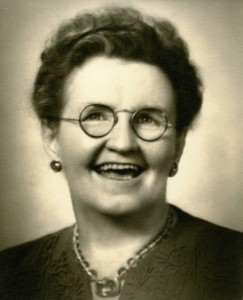 Chouinard offered free scholarships for Disney animators (some of his core animators had already studied at the school). While it was a mutually beneficial relationship, Disney never forgot Chouinard’s generosity, and he later helped to fund her ailing school.
Chouinard offered free scholarships for Disney animators (some of his core animators had already studied at the school). While it was a mutually beneficial relationship, Disney never forgot Chouinard’s generosity, and he later helped to fund her ailing school.
After Disneyland opened in 1955, Walt envisioned a City of the Arts, a place where education and community would coexist: there would be schools where artists-in-residence would not only learn from each other’s disciplines, but they could mingle with a public which could both watch them work and buy their art — and Disney wanted Chouinard as an element of the City. The idea soon proved impractical, but when the financially-strapped Los Angeles Conservatory of Music merged with Chouinard in 1962, Walt’s dream of a permanent school for all graphic and applied arts was born. He would call it the California Institute of the Arts, or CalArts for short. “It’s the principal thing I hope to leave when I move on to greener pastures,” Disney said. “If I can help provide a place to develop the talent of the future, I think I will have accomplished something.”
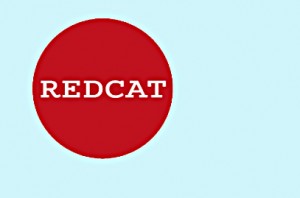 As was the case with most of Walt’s dreams, it would be his brother Roy who would bring the project to fruition. After many fits and starts, CalArts opened its permanent campus in Valencia in 1971, five years after Walt’s Death. (For those who are unaware that a CalArts even exists, it was named the best school for arts-minded students in a 2011 national ranking from Newsweek.) In 2003, CalArts donated $5 million — less than 2% of Walt Disney Concert Hall’s construction budget — for an unobtrusive corner in the Frank Gehry-designed building, and it was named REDCAT, an acronym for the Roy and Edna Disney CalArts Theater (connections didn’t hurt with that steal of a purchase; moreover, two of Gehry’s children had graduated from the Institute). The space includes a 3,000-square-foot gallery for visual art exhibitions, a 200–270 seat flexible black box theater for performing and media art programming, a lounge, and one of the tiniest and the best bookstores in Los Angeles.
As was the case with most of Walt’s dreams, it would be his brother Roy who would bring the project to fruition. After many fits and starts, CalArts opened its permanent campus in Valencia in 1971, five years after Walt’s Death. (For those who are unaware that a CalArts even exists, it was named the best school for arts-minded students in a 2011 national ranking from Newsweek.) In 2003, CalArts donated $5 million — less than 2% of Walt Disney Concert Hall’s construction budget — for an unobtrusive corner in the Frank Gehry-designed building, and it was named REDCAT, an acronym for the Roy and Edna Disney CalArts Theater (connections didn’t hurt with that steal of a purchase; moreover, two of Gehry’s children had graduated from the Institute). The space includes a 3,000-square-foot gallery for visual art exhibitions, a 200–270 seat flexible black box theater for performing and media art programming, a lounge, and one of the tiniest and the best bookstores in Los Angeles.
Now you know why REDCAT serves as the professional presenting arm of the Institute, a venue which, like the mission of its namesake, is a laboratory for visual and performing artists to experiment and redefine the boundaries among disciplines. The projects booked are, for the most part, forward-thinking interdisciplinary work from both local L.A. artists and those from around the world. Plus, REDCAT has and will import a fortune of major work — presented in ideal conditions — that would otherwise go unseen.
As for the Original Works Festival, some in the audience will see it as a thrilling display of emerging artists’ new work. Most others, I suspect, will be intermittently entertained and intrigued, but stymied by some of the multi-disciplinary works, wondering just what in the hell is happening on stage. Akin to visiting a modern art museum, your experience is no doubt subjective; the difference here is that you can’t walk away if you don’t like the work.
Here’s hoping that weeks two and three of the festival don’t contain anything as atrocious as Opera Povera’s To Valerie Solanas and Marilyn Monroe in Recognition of Their Desperation. Even more ostentatious than its title, this dreadfully long piece (over an hour), co-created by Juliana Snapper with director Sean Griffin, was summed up best by two separate audience members: “I’m sorry, but that was the most pretentious piece of shit that I’ve ever seen” and “Come for the novelty. Leave for the boredom.”
Opera Povera’s piece is accompanied by Pauline Oliveros’s 1970 semi-scored and collaborative composition of the same name, which incorporates the egalitarian feminist principles of Solanas’s SCUM Manifesto. What begins as a narrative involving Lana Turner and her daughter Cheryl Crane, quickly becomes a redundant display of more than one drag Marilyn Monroe as she appeared in The Seven Year Itch, a leather-clad daddy who looks like an accountant, and assorted characters wondering on and off stage with the urgency of a slug on lithium. Utilizing a live orchestra, the piece, performed in front of an ambiguous floating white sculpture, means to delve into the functions of gender, or some such theme; instead, it collapses under the weight of ambiguity.
According to George Lugg, associate director of REDCAT, Poor Dog Group’s The Murder Ballad is “a movement-based theater piece or theater-driven dance piece.” Call it what you will, but this non-verbal, gender-bending, mostly solo work displays one of the most amazing movement artists I have ever seen: Jessica Emmanuel. The limber Emmanuel writhes, jumps and poses to Jelly Roll Morton’s Murder Ballad, recorded in 1938. At first, we assume the song must be newly recorded: The lyrics are unbelievably salty, and Morton sings the ballad of a betrayed woman from her point of view; the result feels like a 30-minute pastiche delivered by a gay man (the tune was originally performed in New Orleans’ bordellos). The seven-part ballad tells a tale, but the dance piece does not. As directed by Jesse Bonnell, narrative only sporadically appears, so Emmanuel is left to deliver emotional states that seem incongruous to the music. Even more unclear is the addition of Jesse Saler, who we think will be the man who done her wrong until he dons some earrings. Add to that a voice-over occasionally delivering the numbers “2” and “30,” and the piece becomes stultifying, even as Emmanuel mesmerizes us with her emotional fervency and sly, stealthy felinity.
It’s a shame that so many of the audience bolted after Opera Povera, because puppeteer Susan Simpson’s Exhibit A was the most successful and exciting piece of the night. While the narrative was wholly untraditional, Simpson weaved together writings and journal entries of the denizens of 1950s’ Silver Lake, including gay-libber and Communist Party member Harry Hay. Equal parts history, science-fiction, and story-telling, Exhibit A remained true to avant-garde roots, but unlike the other two pieces, Simpson seems to understand that storytelling, regardless of its form, is the one thing audiences are craving these days. The terrific performers and puppeteers were Mark Simon, Chris Kuhrt, Stephen O. Schilling, Moira MacDonald, Julianna Parr, and Baxley Andresen.
photos courtesy of CalArts and REDCAT
9th Annual New Original Works Festival
REDCAT (Roy and Edna Disney/CalArts Theater)
Week One (reviewed): Opera Povera • Poor Dog Group • Susan Simpson
(Week Two: Nick+James • Jinku Kim • Prumsodun Ok)
(Week Three: Emily Mast • Melanie Rios Glaser • Heather Woodbury)
festival ends on August 11, 2012
for tickets, call 213-237-2800, or visit REDCAT
